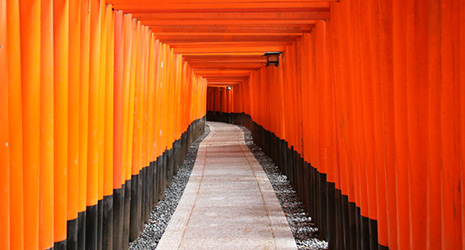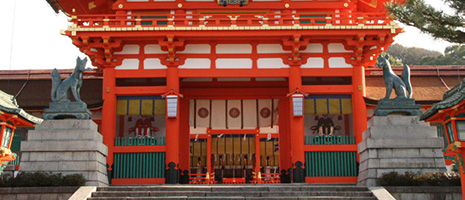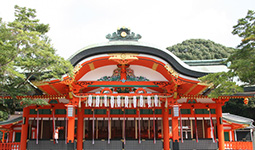INDEX
- English
- 日本語

Senbon Torii, the vermilion torii of Fushimi Inari Taisha - English
- 日本語

Statues of foxes, the messengers of Inari Okami, stand guard at the Tower gate

The main shrine (Honden) at Fushimi Inari Taisha
October 2020
Vermilion Tunnels of Thanks

Vermilion-colored torii gates in their thousands form tunnels on the grounds of Fushimi Inari Taisha Shrine in Kyoto.

Fushimi Inari Taisha is the head shrine of all the Inari shrines, dedicated to the god of the harvest, which are said to number more than 30,000. The paths on the shrine grounds are lined with vermilion-colored torii gates. Torii mark the boundary between the temporal world where people live and the holy precincts of the deities. The tunnels formed by the torii of Inari shrines are regarded as sacred places where people can purify themselves as they pass through.
Fushimi Inari Taisha, built in 711, is located at the foot of Mt. Inariyama in Fushimi Ward, southern Kyoto. Mt. Inariyama in its entirety forms the precinct of the shrine. Along the paths that encircle the mountain, approximately 10,000 large and small torii stand in rows. One path with especially tightly clustered torii forming a tunnel is known as Senbon Torii, meaning “thousands of torii.” Surrounded by the ever-changing beauty of the mountain colors—the greens of spring and summer, the reds and yellows of the autumn leaves and the white of the winter snow—the shrine attracts many worshippers and visitors throughout the year.

Fushimi Inari Taisha enshrines Inari Okami, “a deity who feeds, clothes and houses us and protects us so that all of us may live with abundance and pleasure,” according to shrine texts (http://inari.jp/en/saijin/). In the Edo period (1603–1867), Inari Okami became popular for bringing blessings to ordinary people, such as by ensuring the prosperity of businesses and peace for households. Over time, Fushimi Inari Taisha came to be known affectionately by the name “O-Inari-san.” People visited the shrine to wish for many things or pray for help to overcome misfortune. When their wishes were fulfilled, in return some individuals and companies donated a vermilion torii inscribed with their name. In this way, the number of torii have steadily increased over the years, forming ever-growing torii tunnels along the paths on the shrine grounds.
Tradition dictates that the shrine pavilions and torii are painted vermilion. The color is believed to counteract evil forces and has been used in many palaces, shrines and temples since ancient times. As such, the very color of the shrine and torii itself evokes a powerful sense of spirituality.
The vermilion tunnels of O-Inari-san speak of people’s gratitude and honest hopes for good fortune, prosperity and guidance in overcoming the challenges we face in this mortal world.

